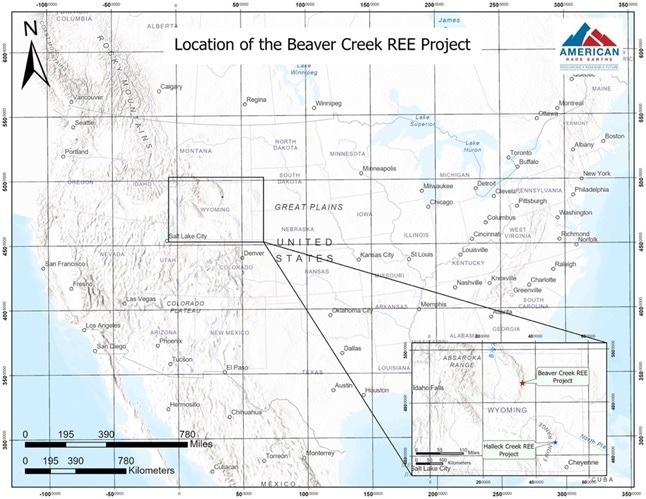American Rare Earths has announced the acquisition of 37 federal unpatented lode claims in Wyoming at a new high-grade rare earth deposit.
 General location of the Beaver Creek REE project. Image Credit: American Rare Earths
General location of the Beaver Creek REE project. Image Credit: American Rare Earths
The claims encompass around 749 acres. Additionally, requests for a mineral lease application for an additional 640 acres have been made to the state of Wyoming. The new region is located north of the company’s flagship Halleck Creek Project and shares many of the same geological features.
These are outstanding results from the initial field work and the exploration team we have on the ground in the United States. The XRF samples show grades up to 91,438 ppm for 5 rare earth elements which includes the highly valuable neodymium, praseodymium and yttrium. The newly staked claims are within the same state as our flagship Halleck Creek project, which already has a JORC Resource of 1.43 billion tons.
Chris Gibbs, Chief Executive Officer and Managing Director, American Rare Earths
Gibbs added, “Given the proximity of these new claims to Halleck Creek, we’re very excited about the future synergies and opportunities between both projects and we look forward to conducting further exploration activities to unlock the potential of this new high-grade discovery.”
The rare earth elements are concentrated in veins rich in allanite, a category of minerals that is a good source of rare earth, according to ARR geologists. Large, 2 to 4-centimeter allanite crystals underwent in-situ portable X-Ray fluorescence (pXRF) studies, with grades ranging from 7.4% to 23.2% La + Ce + Nd + Pr + Y.
When powdered grab samples from an exposed vein rich in allanite were tested, grades ranging from 1.7% to 9.1% La + Ce + Nd + Pr + Y were found.
A historic prospect pit exposes the allanite-enriched vein. The vein is evident in outcrops of calcium silicate rock for 900–1200 feet, according to a 1952 United States Geological Survey report by T. J. Armbrustmacher and K. A. Sargent.
The deposit is still open at both its depth and length. The huge, 2–4 cm allanite crystals found in this study are housed in a quartz, chlorite, and calcite-rich vein that exhibits brecciation, or the process of rock fragmentation. This would suggest that hydrothermal fluids were used to produce the allanite.
The grab samples were delivered to ALS Global for analysis. A rigorous mapping and sample campaign will be expedited to accelerate the project and add to ARR’s understanding of the deposit.